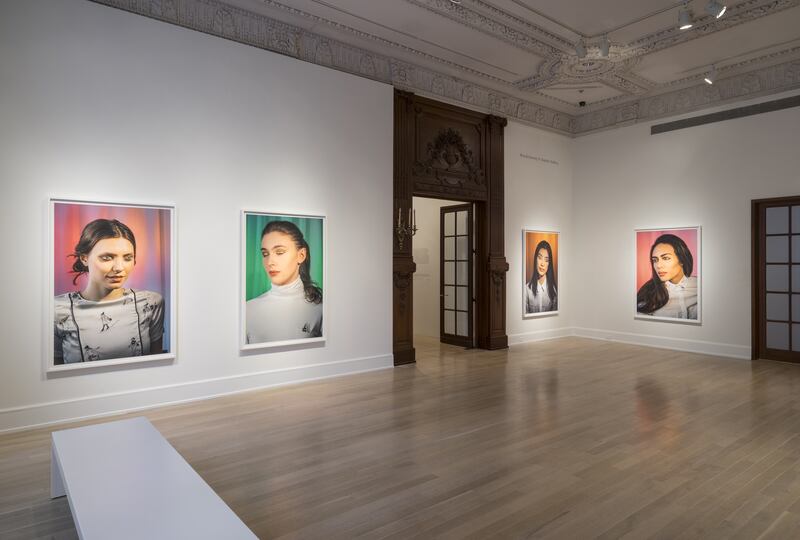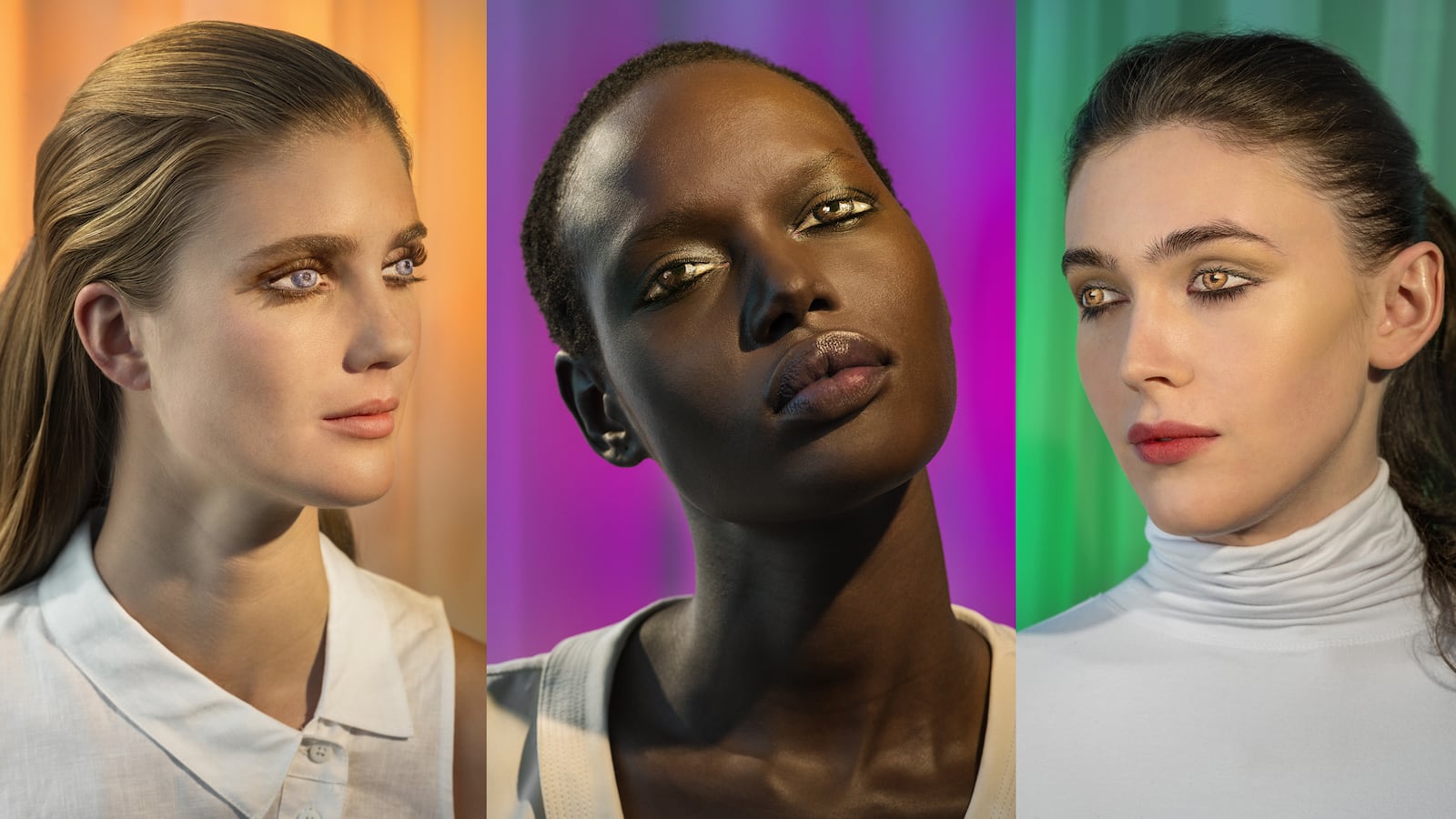Her name is Peche. Her long, dark hair is casually brushed to one side, revealing the subtle embroidery on her shirt collar—the words “NO!” and the outline of a cigarette.
Her makeup is flawless against her bronzed skin as the soft pink background highlights a set of piercing brown eyes that gaze into the distance. There’s nostalgia laden within the life-size photograph, evoking a sense of glamour from studio portraits of the early 90s.
Except, something is off. In fact, her eyes aren’t really open. They’re tightly closed.
The lifelike recreation on top of her lids are the markings of Laurie Simmons’ latest body of work, How We See, which opens this Friday at the Jewish Museum in New York City.
“It’s very concretely in the world of anime and cosplay,” Simmons told The Daily Beast of the make-up process behind the works. “And I really loved this idea of being blind but being able to see at the same time.”
The six large-scale photographs draw inspiration from the “Doll Girl” community in which people take on the persona of Barbie dolls and Japanese anime. It’s given us a real-life Barbie and Ken as well as a riveting My Strange Addiction episode focused on men who dress in doll suits.
But for Simmons, it’s inspired something even greater, allowing her to capture human portraits comfortably for the first time in her forty-year career.
“I’ve tried with varying degrees of failure to bring [people] into my work,” Simmons said. “I was never capable of shooting a portrait, but as soon as this one bit of artifice entered the image I felt completely comfortable.”
Simmons has been capturing dreamlike photographs—mostly consisting of tiny dolls and furniture, ventriloquist dummies, and large objects teetering on human legs—since the mid-1970s.
She’s also appeared in the film Tiny Furniture, which was written and directed by her daughter Lena Dunham. In it, Simmons played Siri, the mother to Dunham’s character, Aura, and an artist who photographs tiny furniture much like Simmons’ professional persona.
“We may resist it but the family is getting used to the fact that in Lena’s world we’re all fair game,” Simmons told the Telegraph earlier this year. “In my mid- to late-20s I started taking lots of pictures of my parents. I was trying to mine my past to understand who I was in the present. So I have a lot of compassion and sympathy. I may not always love it, but I certainly accept it.”
In the film, Dunham used Simmons’ actual diaries as script and props, revealing the intimate details from her childhood that paralleled much of Aura’s own troubles. Bits of Dunham’s personal life has seemed into every aspect of her work, including her HBO series Girls and her recent New York Times best-seller, “Not That Kind Of Girl.”
“I think I’m a much more private person,” Simmons said at a Women in the Arts luncheon hosted by the Brooklyn Museum in 2013 and honored the artist and her daughter. “I know that’s a funny thing to say, a strange thing to say with a daughter like Lena Dunham. She has attempted to wrest so much personal information from my life and my past—that’s been the point of tension in our relationship. It’s like you’re living with a journalist.”

But it wasn’t until a trip to Japan with her other daughter, Grace, in 2009 that she stumbled upon the inspiration for a completely radical new body of work—a “Love Doll,” or a life-size (and lifelike) female doll that is generally used as sexual aides.
Simmons ordered two and began dressing them up and photographing them at her home in Connecticut.
The images show the two women curious of their surroundings—they swim, jump over walls, and relax at home. By the end of the series Simmons had dressed them as geishas, giving them a strikingly realistic persona that would have anyone questioning their human existence.
Then, in 2013, she began incorporating actual humans into her photographs. She began working with the practice of Kigurumi, a subset of cosplay that involves people dressing up as dolls. Employing a cosplayer from Russia to create giant, custom made masks, Simmons dressed her models like bright-eyed anime characters and photographed them.
Related: A Doll’s Life: Laurie Simmons Explores Kigurumi
The portraits alternate between casual activities and pre-posed “selfies.” One model, in bright red latex dress and electric blue hair, poses in what seems to be a scaled down attic, referencing the doll and the dollhouse so familiar to Simmons’ work.
Another holds a dog while she lies in an empty bathtub. The mask’s oversized, bright green eyes give a sense of excitement and happiness while the stoic face evokes a chilling loneliness. It’s a perplexing dynamic that will both captivate and intrigue onlookers.
It was in the process of researching the Kigurumi and the maskers that Simmons stumbled upon a plethora of YouTube videos demonstrating how to paint anime eyes on top of your real ones. She hired two makeup artists—James Kaliardos and Landy Dean—to apply the eyes and enlisted designer Rachel Antonoff, the sister of Dunham’s boyfriend—Jack Antonoff, to supply the outfits.
The models came almost intuitively. While working with Kaliardos, who did make-up for Bruce Weber’s 2014 Barney’s campaign, Brothers, Sisters, Sons & Daughters, which featured an all transgender cast, Simmons was taken aback by their beauty and immediately wanted to bring them into her work. Two—Peche and Edie—are featured in How We See.
“She always takes her work just a little step further each time,” Kelly Taxter, the exhibition’s assistant curator, told The Daily Beast. “I think a lot of her previous work has looked at the past … then, she started the “Love Doll” series and really started to look forward into a more present and futuristic phenomenon that’s happening online.”
Laurie Simmons: How We See will be on display at the Jewish Museum, 1109 5th Avenue, from March 13 to August 9, 2015.





